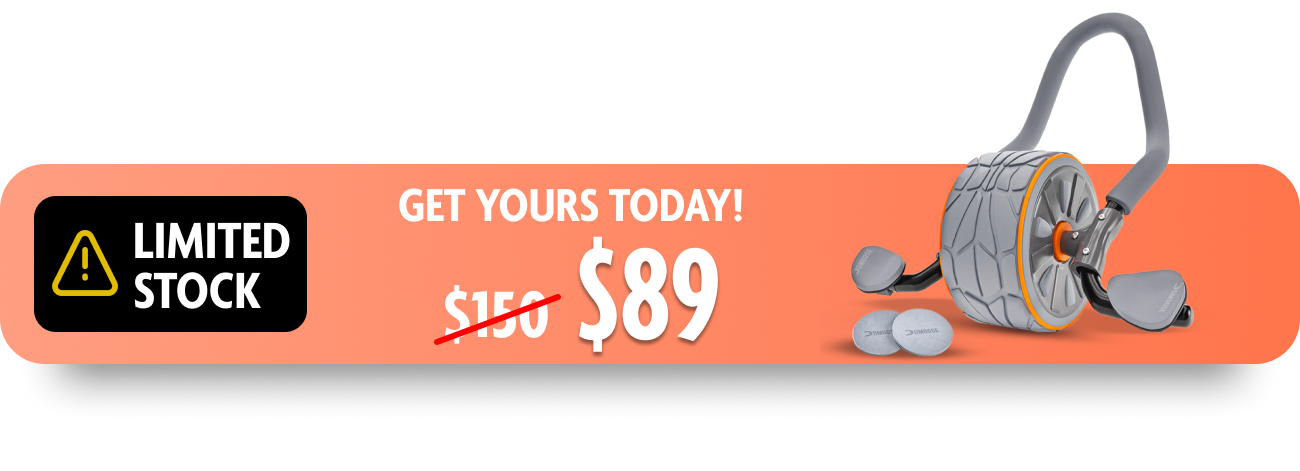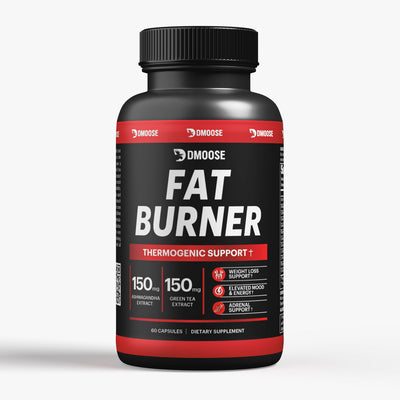Have you been struggling to lose stubborn belly fat? You're not alone! Many people, regardless of age or gender, have noticed the importance of having a flat abdomen to feel comfortable and confident. But achieving that goal can seem elusive, leaving many frustrated and discouraged.
Fortunately, science has found some answers about how long it takes to burn off excess abdominal fat effectively - and it might surprise you! In this blog post, we'll take an in-depth look at scientific studies uncovering the truth behind how long you can expect your journey toward a ripped stomach to last - so keep reading if you want to achieve the body of your dreams finally!
Getting rid of stubborn belly fat can be a tough challenge for dieters. To have a flat stomach, you must create a caloric deficit over 6-12 weeks by consuming fewer calories, exercising more, and being consistent with these habits.
Let's look at what science can tell us about getting rid of pesky fat and achieving those flat-stomach dreams. We'll explore factors that could impact your journey to toned tummy territory!

Realistic Timeline to Get a Flat Stomach
Getting a flatter stomach can be accomplished; it depends on your starting point and how you define flatness. People with more abdominal fat may require more time to reduce their fat than those with less to lose.
The amount of time needed to achieve this can depend on several factors, which we will explain further. Everyone has a different idea of what a flat stomach should look like, so for this article, we will focus on how to get a flatter stomach than your current situation. But before starting over, let's first see the stages of fat loss.

Stages of Fat Loss
Losing fat isn't the easiest of tasks, but if you break it down into its respective stages, you can achieve your fitness goals in no time! Start by creating a caloric deficit for yourself that is sustainable over time. Usually, the fat loss process passes through 4 stages. Let's explore them.
1. Glycogen Depletion
Your body stores sugar and glycogen to fuel thinking and maintain body temperature and movement. Generally, a human will have up to 300-400 calories of glycogen in the liver and 2,000-10,000 calories in the muscles. The liver is like a cup, a fixed size that can be filled and emptied.
Muscles act like balloons; they can visibly swell and shrink, and the more you exercise, the more they can hold. If you enter a calorie deficit, your body will exhaust the glycogen stored in the liver and then a small percentage of the glycogen in the muscles.
It is like spending from your savings account; your body won't deplete the muscle stores. The glycogen depletion stage typically lasts 36 to 48 hours after exercise. When used up, it will look to body fat stores for energy.

2. Fat Loss
It is an ideal weight loss range to strive for. During this stage, you must feel a bit hungry before meals but not overly so, have plenty of energy, and sleep while witnessing a consistent decrease in your weight.
It can depend on your individual goals and the type of diet and exercise plan you are following. Science says that the fat loss stage of a weight loss program can last anywhere from a few weeks to several months, depending on your body weight.

3. Plateau
When going on a weight loss journey, you may be in a state of plateau when you have been overzealous with creating a caloric deficit. It is when your body decreases the energy it spends, which ultimately sabotages your efforts.
The length of a plateau fat loss stage can vary significantly based on the individual's lifestyle and methods to reach their weight loss goals. Generally speaking, a plateau fat loss stage can last a few weeks to several months.
If you find yourself in a situation where fat loss has stopped, your workout performance has declined, and your body looks or feels like it's losing tone, it's time to move into stage 4 as soon as possible.
4. Metabolic Recovery
A study says that it is necessary to restore your metabolism to its regular rate. It's like getting back on track. As you give your body more fuel, it can gradually return to its usual function.
The metabolic recovery stage of fat loss typically lasts around 4-7 days. During this stage, the body can repair and restore its metabolic rate, allowing it to burn more calories and get back on track with fat loss.
Lifting Vs. Running Does It Matter?
According to a study, if you are an average novice runner who began running more than 5 km a week and made dietary modifications to lose weight, you can decrease your belly fat over one year.
When it comes to lifting weights versus running, both are necessarily better for achieving a flat stomach. Instead, both can be beneficial, depending on the individual's goals. Lifting weights can help preserve muscle, increase metabolism, and burn more calories when cutting. Adding in some running can be helpful for those who have their diet and lifting program in check.
Related Article: Can Walking Help You Lose Weight?
Does Age Matter?
As we age, it is often more challenging to shed fat due to decreased muscle mass, slower metabolism, and a sedentary lifestyle (long working hours, inadequate sleep, and poor diet).
However, one study found that aging increases abdominal fat deposition. Even though there are hormonal changes associated with aging, it is still possible for people to lose weight later in life, though it can take more effort and time.
Science-Backed Ways of Losing Fat
Can you get your fat-loss resolutions on track? Check out these science-proven tips to kickstart that transformation!
Eating Plenty of Fibers
Soluble fiber has been linked to weight loss and potentially decreased belly fat. Research has found that if you consume an additional 10 g of this type of fiber, your belly fat can decrease by 3.7% over 5 years.
It is likely due to how soluble fiber absorbs water and forms a gel-like substance that helps move food through the digestive system more slowly, leading to fullness. Soluble fiber can be found in various sources, including fruits, vegetables, legumes, oats, and barley. Remember to take your dose of probiotics with all this.
Avoid Food That Contains Trans Fat
Hydrogen is added to some unsaturated fats, such as soybean oil, to create trans fats. Previously, these types of fats were used by many food producers and were found in some types of margarine and spreads.
A 16-week double-blinded parallel intervention study concluded that consumption of trans fatty acids for a short period couldn't cause accumulation of body fat; however, in the long run, they not only cause belly fat accumulation but can also lead to cardiovascular diseases.
So, this study breaks the myth that consuming trans fats help in belly fat reduction. Therefore, it is not recommended to consume trans fatty acids to lose belly fat. However, you can always open your doors to fat burners.
Cut Down on Alcohol Consumption
An old study has indicated that excessive consumption of alcohol can lead to the accumulation of fat around the waist. Evidence has revealed that daily drinkers, who consume only a single drink, are likelier to have less abdominal fat than those who drink less frequently but consume more alcohol on the days they consume it.
So, once you quit drinking and combine it with healthy eating and regular exercise, you can lose belly fat within a year.
Eating High Protein Diet
Protein is essential for successful weight management. It is impossible to give an exact number of days since everyone's body is different and responds differently to diet changes.
Another study demonstrated that consuming more protein and a caloric deficit diet can reduce abdominal fat in a few weeks. Including a protein-rich food at each meal, such as meat, fish, eggs, dairy, whey protein, or beans, is recommended. You can also add multivitamins to your diet to meet the demands of proteins and minerals.
Reduce Stress
Stress can cause you to accumulate belly fat by activating the adrenal glands to secrete cortisol, the hormone associated with stress. Studies have demonstrated that high cortisol concentrations increase hunger and cause fat to be stored around the abdomen.
Research says that the caloric deficit is the key, and if you maintain a healthy exercise plan and manage your stress, you can lose belly fat in as early as 4 weeks. Further, you can also add supplements like adaptogen to reduce stress levels.
Practice Cardio
Aerobic exercise can benefit your overall health and help you burn calories. Though the results of whether moderate or intense exercise is more effective are mixed, it is essential to note the frequency and duration of exercise when attempting to reduce belly fat.
A study found that those who did aerobic exercise for 300 minutes weekly lost more fat from all areas than those who did it for 150 minutes weekly. However, the changes in visceral belly fat were not significantly different. You can expect results in at least two to three weeks with consistent effort and dedication.
Performing Resistance Training
If you are at risk of prediabetes, type 2 diabetes, or fatty liver disease, strength training may effectively reduce belly fat. It has been shown that a combination of strength training and aerobic exercise can lead to
the most significant reduction in visceral fat, especially among overweight teens.
The time it takes to reduce fat through resistance training depends on many factors, such as your current body composition, the type of exercises you are performing, and how often you are training. A study states that it can take 4-12 weeks to start seeing noticeable results.
Consider Intermittent Fasting
Intermittent fasting has recently become a popular technique for weight loss. This eating plan cycles between periods of eating and periods of not eating. One example is fasting for 24 hours one or two times a week. Another version is fasting for 16 hours daily while consuming all meals within an 8-hour window.
A study found that when intermittent fasting was combined with protein pacing (which involves eating nutrient-dense meals regularly throughout the day), it resulted in more significant decreases in body weight, total fat, and visceral fat than calorie restriction. It depends on the individual and their current diet and exercise routine.
Generally, results can be seen within a few weeks to a few months. It is recommended to start with shorter fasting windows (14-16 hours) and gradually increase the fasting window length (up to 24 hours) as your body adapts to intermittent fasting. Additionally, it's essential to maintain a healthy diet and exercise to reach your desired results.
Ways to Speed Up the Process of Getting a Flat Stomach
Struggling to say goodbye to the belly bulge? You can transform your tummy with these simple steps and flaunt a flat stomach that can make Instagram jealous!
No Cheat Days
Losing fat can be difficult due to decreased muscle mass, metabolism, and an increasingly inactive lifestyle. However, one study found that subcutaneous fat increase was independent of age and dependent on the degree of obesity.
Instead of being overly restrictive or over-exercising during the week to make up for the weekend, weekends should be treated like any other day in terms of diet and exercise. It may be less fun, but it is a more sustainable approach for long-term success.
Quit Drinking Alcohol
Too much alcohol can harm your waistline and cause fat to be stored in your body more efficiently. It is essential to reduce alcohol consumption and to focus on eating healthily and exercising regularly.
Studies have shown that both the frequency and intensity of drinking are linked to increased abdominal fat in both men and women. Binge drinking was found to have the strongest correlation with abdominal fat.
Workout 5+ Days Weekly
You need to increase your energy output if you do not exercise five days a week and follow a healthy diet. It can be accomplished by increasing the steps or adding an extra workout (or whatever you must do to train five days a week).
It is important to note that you don't have to lift weights five days a week to lose weight. However, for those who are trying and failing to lose weight and are already eating right, working out only 2-3 times a week, and leading a moderately active lifestyle, adding in an extra two workouts each week can be just the boost they need.
Increase Daily Step Count to 8000+
Incorporating 8,000 steps into your daily lifestyle can benefit your BMI and overall health. These results are even more favorable when compared to a sedentary lifestyle that only includes 30 minutes of cardio.
Therefore, if you want to reduce BMI and waist circumference, it is recommended that you increase your step count and engage in more physical activities outside the gym in combination with a diet and exercise plan.
Related Article: How to lose belly fat naturally and safely?
FAQs
1. How long does it take to lose belly fat by walking?
The amount of time it takes to lose belly fat by walking varies from person to person, depending on their body composition, starting weight, and fitness level. That being said, the general goal for many people to slim down their midsection is about 8-12 weeks. As a general rule of thumb, creating a balanced program that integrates cardiovascular exercise with strength training is essential for optimal results. It can support both fat loss and the improvement of overall physical conditioning.
2. How long does it take to lose belly fat by running?
The amount of time it takes to lose belly fat by running varies from person to person, depending on their body composition, starting weight, and fitness level. That being said, the general goal for many people to slim down their midsection is about 8-12 weeks of regular running exercise. Of course, like any other exercise program, you should start slowly and gradually work your way up as your body adjusts and strengthens.
3. How long does it take to lose belly fat and love handles?
Losing belly fat and love handles can take some time and should be done healthily and safely. It is important to remember that everyone's body is different, so the amount of time it will take for you to lose the fatty deposits around your midsection may vary from others. Generally speaking, if you practice healthy eating habits and exercise regularly (aiming for at least 150 minutes of moderate-intensity physical activity each week), you could begin seeing results within 3-8 weeks.
4. What are signs you are losing belly fat?
Following are signs that you are losing belly fat:
- You Feel Less Bloated: As the body begins to lose belly fat, it will process foods more efficiently and absorb fewer calories.
- Your Waist Is Getting Smaller: One of the most obvious indications that your efforts are paying off is when clothes start getting looser at the waistline.
- You're Experiencing Better Digestion & Metabolism: When an individual loses excess weight (including abdominal fat), they tend to experience improved digestion & metabolism.
- Your Abs Are Suddenly More Visible: Once you have gradually started reducing belly fat through diet or exercise, you will likely notice your abs are more visible.
Takeaway
Ultimately, there is no one-size-fits-all program for everyone regarding belly fat. People aim to lose belly fat at different rates, depending on how much body fat they have. With that in mind, know that changes can be made to improve your waistline. Get started by experimenting with different diets that listen more to your body than your cravings.
Follow that up with anaerobic exercises meant to target the muscles around the core of the stomach, such as running and jogging, crunches, burpees, and planks. Having a clear goal and consistent work ethic will help you reach whatever milestone figure you are looking for swiftly and without fail. Good luck!
Reading List
Article Sources
- Bendsen, N. T., et al. "Effect of Trans Fatty Acid Intake on Abdominal and Liver Fat Deposition and Blood Lipids: A Randomized Trial in Overweight Postmenopausal Women." Nutrition & Diabetes, vol. 1, no. 1, Jan. 2011, p. e4. PubMed Central, https://doi.org/10.1038/nutd.2010.4.
- Hewagalamulage, S. D., et al. "Stress, Cortisol, and Obesity: A Role for Cortisol Responsiveness in Identifying Individuals Prone to Obesity." Domestic Animal Endocrinology, vol. 56 Suppl, July 2016, pp. S112-120. PubMed, https://doi.org/10.1016/j.domaniend.2016.03.004.
- Jura, Magdalena, and Leslie. P. Kozak. "Obesity and Related Consequences to Ageing." Age, vol. 38, no. 1, Feb. 2016, p. 23. PubMed Central, https://doi.org/10.1007/s11357-016-9884-3.
- Kim, Bo-Yeon, et al. "Obesity and Physical Activity." Journal of Obesity & Metabolic Syndrome, vol. 26, no. 1, Mar. 2017, pp. 15-22. PubMed, https://doi.org/10.7570/jomes.2017.26.1.15.
- Kim, Ju Young. "Optimal Diet Strategies for Weight Loss and Weight Loss Maintenance."Journal of Obesity & Metabolic Syndrome, vol. 30, no. 1, Mar. 2021, pp. 20-31. PubMed Central, https://doi.org/10.7570/jomes20065.
- Li, Ji-Bin, et al. "Gender Differences in Factors Associated with Clinically Meaningful Weight Loss among Adults Who Were Overweight or Obese: A Population-Based Cohort Study." Obesity Facts, vol. 14, no. 1, 2021, pp. 108-20. PubMed, https://doi.org/10.1159/000512294.
- Nielsen, Rasmus O., et al. "Does Running with or without Diet Changes Reduce Fat Mass in Novice Runners? A 1-Year Prospective Study." The Journal of Sports Medicine and Physical Fitness, vol. 56, no. 1-2, 2016, pp. 105-13.
- Redman, Leanne M., et al. "Effect of Calorie Restriction with or without Exercise on Body Composition and Fat Distribution." The Journal of Clinical Endocrinology and Metabolism, vol. 92, no. 3, Mar. 2007, p. 865. www.ncbi.nlm.nih.gov, https://doi.org/10.1210/jc.2006-2184.
- Shuster, A., et al. "The Clinical Importance of Visceral Adiposity: A Critical Review of Methods for Visceral Adipose Tissue Analysis." The British Journal of Radiology, vol. 85, no. 1009, Jan. 2012, pp. 1-10. PubMed Central, https://doi.org/10.1259/bjr/38447238
- Solah, Vicky A., et al. "Effect of Fibre Supplementation on Body Weight and Composition, Frequency of Eating and Dietary Choice in Overweight Individuals."Nutrients, vol. 9, no. 2, Feb. 2017, p. 149. PubMed Central, https://doi.org/10.3390/nu9020149.
- Swift, Damon L., et al. "The Role of Exercise and Physical Activity in Weight Loss and Maintenance." Progress in Cardiovascular Diseases, vol. 56, no. 4, 2014, pp. 441-47. PubMed Central, https://doi.org/10.1016/j.pcad.2013.09.012.
- Welton, Stephanie, et al. "Intermittent Fasting and Weight Loss: Systematic Review." Canadian Family Physician, vol. 66, no. 2, Feb. 2020, p. 117. www.ncbi.nlm.nih.gov, https://www.ncbi.nlm.nih.gov/pmc/articles/PMC7021351/.


















